Introduction
The United Nations statement reflects International trends towards the transformation of educational systems in order to bring them more in line with economic and social needs. The United Nations Educational, Scientific and Cultural Organization (UNESCO, 2011) has expressed the need to consider multilingual and multicultural competencies in educational design policy in order to facilitate contact between multiple languages and cultures (Delors et al., 1996, p.31). In the same vein, the Organización para la Cooperación y el Desarrollo Económico (OCDE, 2001) has stated that citizens should have an education based on life competencies that permit them to adapt to a complex and changing world. In accordance to this, the Secretaría de Educación Pública (SEP) in 2008 “started the National English Program in Basic Education (NEPBE) from which syllabuses for the three levels of Basic Education are derived. Such syllabuses are devised based on the alignment and standardization of national and international standards” (SEP, 2010, p.85).
Program Characteristics
The trial and implementation phases of NEPBE for 2009-20012 have been completed and now the NEPBE is in the expansion phase. Every school in the country must be incorporated into the program by 2018. During the first expansion phase the program is structured in 4 cycles that correspond to the three levels of basic education. The program of study for English as a second language in Basic Education has two distinctive features: they are distributed in cycles and not academic years in order to “ensure continuity and articulation in different academic years and levels of education” (SEP, 2010, p.11). In addition, the programs of study are flexible because they present a guide of sequences and contents that teachers can adapt according to the context. The program contents are essential and are defined by the social language practices and specific competences (SEP, 2010).
The social practices of language represent the approach for the language teaching adopted by the Secretariat of Public Education and the core referent in the definition of NEPBE’s contents… They are patterns or ways of interaction, which, in addition to the production and interpretation of spoken and written texts, include several activities linked to them. Each practice has a specific communicative purpose and a history linked to a particular cultural situation. (SEP, 2006, p. 9)
Competence is the capability to perform a task or deal with different situations resourcefully; in order to do this the individual should combine attitude, ability and knowledge (SEP, 2012). Derived from the general competences the specific competencies students have to develop “are conceived as complex and articulated configurations of the doing with, knowing about, and being through the language, whose purpose is to preserve the formal aspects and functions of language within social life” (SEP, 2011, p. 25).
The foundations of the NEPBE curriculum are mainly based on the socio cultural theory (also called social constructivism) proposed by Vygotsky (1995), which highlights learning that is generated in everyday communication (social life) such as in those activities directed towards the acquisition of language through three types of “knowledge”: doing with the language, knowing about the language, and being through the language (Vargas Ortega & Ban, 2011). Similar to Vygotsky (1995) Bandura (1978) sustains that learning takes place in a social environment in interaction with people, as a consequence of our own actions or through the observation of models (Bandura, 1987). Likewise, Piaget (1979) sustains that cognitive development follows an invariable sequence of stages that develop throughout one´s life and that vary in length and social environment. In sum, the socio cultural theory of Vygotsky (1995) is an extension of the work of contemporary psychologists and is the basis of the social practices proposed by the NEPBE.
We are particularly interested in the social practices contained in the syllabus of cycle II of the NEPBE, which has as a general purpose that “students acquire in a progressive fashion the basic communicative competence in order to be able to participate successfully in specific competencies appropriate to the social practices which involve interaction with oral texts and written texts in known situations” (SEP, 2010, p.15). Table 1 shows 10 of the 20 social practices of language for cycle II that promote the development of all four skills (listening and reading comprehension, speaking and writing production) in an interactive way.

Table 1. Cycle 2 Distribution of social practices of the language by environment
Literature review
There are two studies that are closely related to the present work. The first, Múnera Elorza’s (2007) study carried out over a three year period, had as its main objective to identify the type of teaching strategies used by teachers in the first and second year of elementary school and their effectiveness in students’ learning of English in the Education Center of “Rural la Hermosa” in Toruro, Enterrios Colombia. Múnera Elorza (2007) based her study on the competencies approach to propose educational strategies for teaching English. She collected data using three instruments; a semi-structured interview applied to teachers, class observations, and a diary. After five months of observations she proposed several teaching strategies based in both her research and Vygostky’s concept of zone of proximal development; she designed school workshops and follow up activities in which parents had to support their children at home. She proposed transverse teaching of natural science, technology, social science, physical education, and artistic education with English class. The workshop results showed that the project contributed to the practice and learning of teaching strategies on the part of the teachers and also the improvement of children’s interest and motivation. Parents’ participation allowed children to practice English at home.
The second study that is related to ours is Villasana Usry’s (2011) study. The objective of her study was to design teaching strategies for a group of fifth-graders in an elementary school in “Primaria Rafael Nieto” in San Luis Potosi, Mexico. Villasana Usry based her didactic proposal in the socio cultural approach and social practices of the NEPBE. Her research method was a qualitative one and has an empirical phase implementing a didactic proposal. The instruments she used to collect the data that was later used to design the English teaching strategies were a diary to take notes in class, and a survey she applied to teachers and students.
The strategies were designed based on the data she had collected and the reflexive cycle of Smyth (1991); describe, explain, confront and reconstruct. Villasana Usry applied a pre-test to students before using the strategies she designed. After using the strategies for teaching English to the same students she applied an achievement test. The conflict areas she found were in syntax, semantics and speaking. Munera and Villasana’s studies are similar to our study because we are also interested in exploring the use of didactic material to implement the social practices of language in elementary schools, however we used different instruments to collect the data in our study. Our concern was to detect the existing problems in Nayarit, in relation to the implementation of the teaching practices proposed by the NEPBE for cycle II.
Methodology for the study
The methodology used for this research is mixed; qualitative and quantitative data was collected. We designed an open questionnaire to obtain information without limits about the teachers´ experiences and the problems they face implementing the NEPBE as well as a closed questionnaire that aimed to collect more quantitative data from a larger number of teachers about the social practices of the language, didactic material and infrastructure matters.
Instruments
In order to design the instruments for this study we took into account several aspects that allowed us to understand the particular conditions in which the English language is taught in cycle II in Nayarit. In addition to inquiring about the social practices and the teachers’ perception of the students’ acceptance of the same, we included some aspects stated in the NEPBE curricula foundation; such as the use of didactic resources, access to printed material and multimedia in English, as well as the use of oral and written texts of different nature (SEP, 2011, pp. 19, 21).
Open questionnaire: The open questionnaire has two parts. The first part collects personal information in order to find out more about the characteristics of the teachers, the schools where they work, their English training, command and certification, as well as their experience as English teachers. The second part has 10 questions (appendix 1) question one to four are about the social practices of language that students like best or do not like at all and the alternatives teachers used instead of the activities students did not like. Question 5 is in relation to the students learning style, question 6 is about didactic material, question 7 enquires about the problems teachers have when planning a lesson and the activities for that lesson, question 8 is about the problems they have with the material provided by the NEPBE and questions 9 and 10 are about the teachers´ needs for teacher training. In order to apply this questionnaire we gave teachers a handout with charts showing a summary of the 20 Social practices of language that correspond to cycle II of the NEPBE (SEP, 2010); this handout was useful for the teacher because they could answer by just using the number of the social practice.
Closed questionnaire: The closed questionnaire has 7 questions. Question 1 and 2 asks teachers of 3rd and 4th grade their opinion about their students’ acceptance of the 20 Social practices of language; which ones they liked the best and which ones they did not like at all. Question 3 used a likert scale to find out the frequency with which teachers used different education material. In questions 4 to 7 teachers had to answer questions about the problems they face in relation to the didactic material that they are provided with, the facilities and technology equipment in the schools where they were teaching, as well as the support they have from the principal of the school where they worked (appendix 2)
SPSS and Excel: Software used for the quantitative data analysis and graphic design.
Subjects
The closed questionnaire was applied to 58 teachers, 32 women and 26 men; their average age is around 32 years old. Most of them have an acceptable command of English, however they do not have a degree in English teaching and many of them do not have previous experience teaching English. It is important to mention that only 43 of them returned the questionnaire answered.
The open questionnaire was applied to 12 teachers of English currently teaching in cycle II who were willing to dedicate more time to answer the questionnaire; 67% of them are women and 33% of them are men with an average age of around 32 years old. 75% of the teachers belong to urban schools while 25% of them belong to rural schools. Not all the basic education English teachers have a certification as English teachers; they are sometimes hired to do the job based on their command of the English language or because of administrative issues. After applying the open questionnaire, we were able to obtain more information about them due to the fact that the first part is dedicated to collecting personal information about the teachers (see results section).
Procedure
The questionnaires were applied in September 2012 to teachers currently teaching in cycle II of the NEPBE program, but also to teachers currently teaching cycle I and III who have also taught in cycle II. Questionnaires were given to teachers attending a teacher training conference with permission having been received in advance from the authorities. We asked the 58 teachers attending the conference to answer the closed questionnaire but only 43 of them were willing to do so. The open questionnaires were applied to 12 teachers who were willing to spend some more time answering the questions
Results
Open questionnaire
75% of the teachers in cycle II have a bachelor degree, 17% of them have knowledge about the methodology of English teaching and 67% of them have some sort of English language certification, which does not mean that they are foreign language teachers. According to their answers 42% of the teachers have an advanced level of English 50% of them have an intermediate level and 8% have an initial level of English. Concerning their experience with EFL teaching 8% of the subjects have been teaching English for more than 10 years, 25% for more than 5 years, 17% for more than 4 years, 17% for more than 3 years, 8% for more than 2 years and 8% for more than one year.
The data collected from the second section of the questionnaire was grouped under 7 headings in which we report the perception of the majority of the teachers for each heading:
1) Social practices the students like best: Most of the teachers reported children like the following activities best: The children liked children’s song and booklets with song lyrics because most like to sing and dance, cross words because the students are familiar with the vocabulary they practice when performing the activity, comic strips because the students transmit positive messages and develop their creativity. Teachers also noticed the children like tongue twisters because they are competitive.
2) Social practices the students don’t like: The children do not enjoy the audio story and radio reading because they think the readings are complicated and they don’t understand them. They do not like making diagrams and are not very interested in the guide of curious questions.
3) Students learning styles: Most teachers state that their students are kinesthetic and visual students.
4) Didactic material: Teachers obtain the material to adapt the practices from the Internet, in magazines, or they buy new material.
5) Problems teachers have when planning a lesson: They state that they have problems designing the material and activities according to the NEPBE and that time management in class is also a problem for them.
6) Problems they have with the material provided by the NEPBE: They have problems with the articulation of the stages in order to obtain a product. In addition, teachers think that the problem they face with the material is that the English level of the textbook provided by the program administration is too high for the students they teach.
7) Teachers’ needs for teacher training: The teachers would like to be trained in student discipline and management, as well as design of teaching-learning strategies.
Closed Questionnaire
We can see in Figure 1 that students accept most of the social practices of language for third-graders in elementary school, which shows that students are happy with the social language activities proposed by the NEPBE. In Figure 2 we can observe the same situation with the students in the 4th year of study; it shows that most of them like the social practices of language.
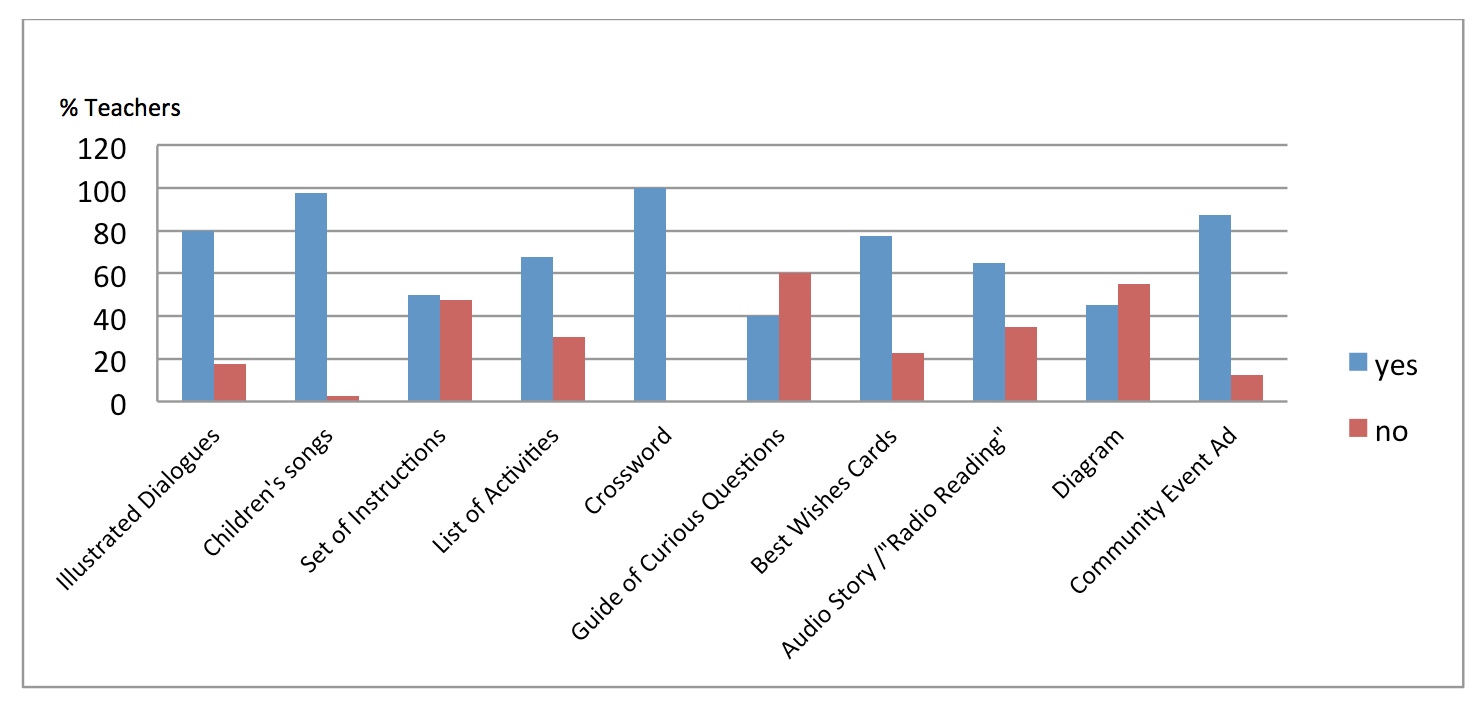
Figure 1: Acceptance of products 3rd grade
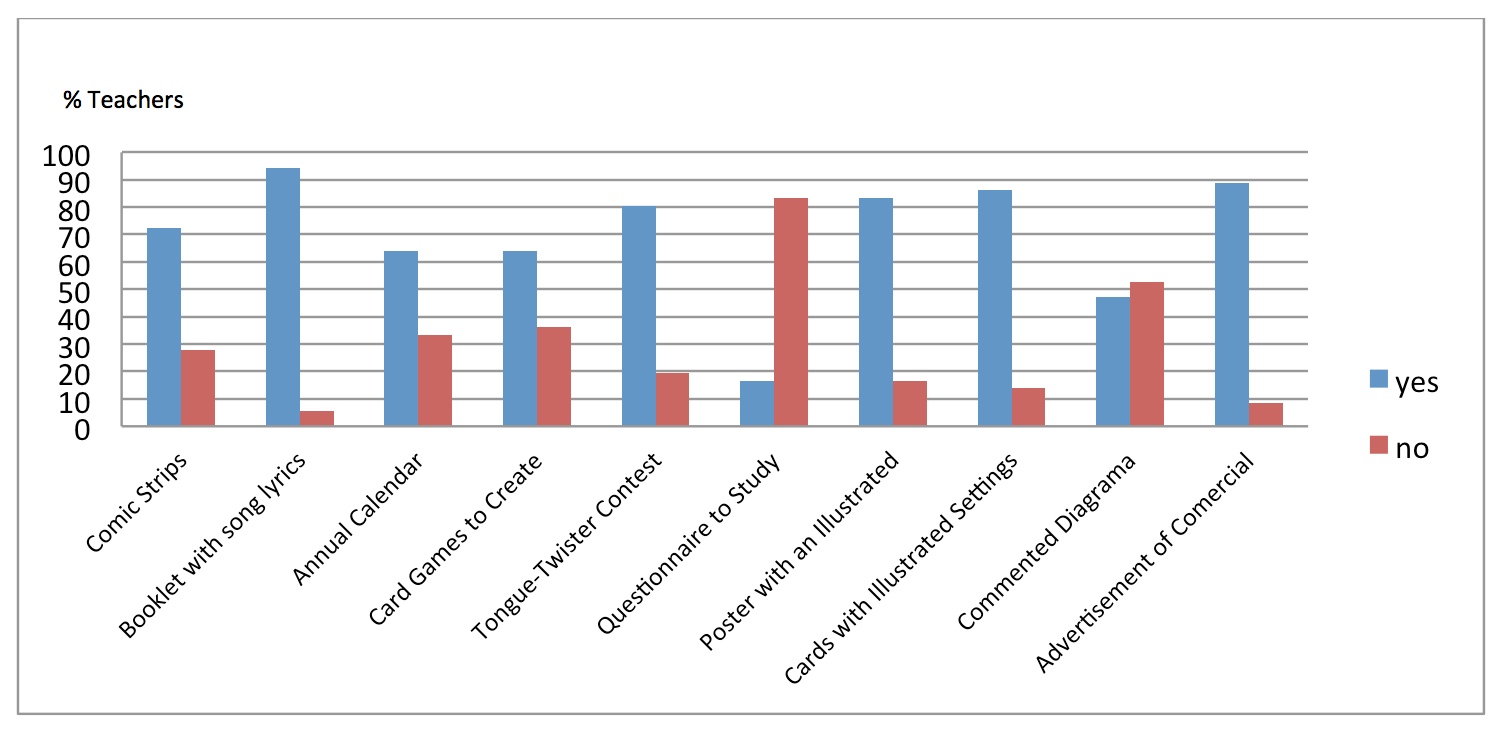
Figure 2: Acceptance of products 4th grade
In Figure 3 we can see that over 50% of teachers who answered the questionnaire did not use technology for teaching their classes or performing the social practices of language. The bottom line in Figure 3 represents those teachers who answered that they do use technology a little, more or less, almost always and always. The line above that shows the teachers who answered that they do not use technology at all.
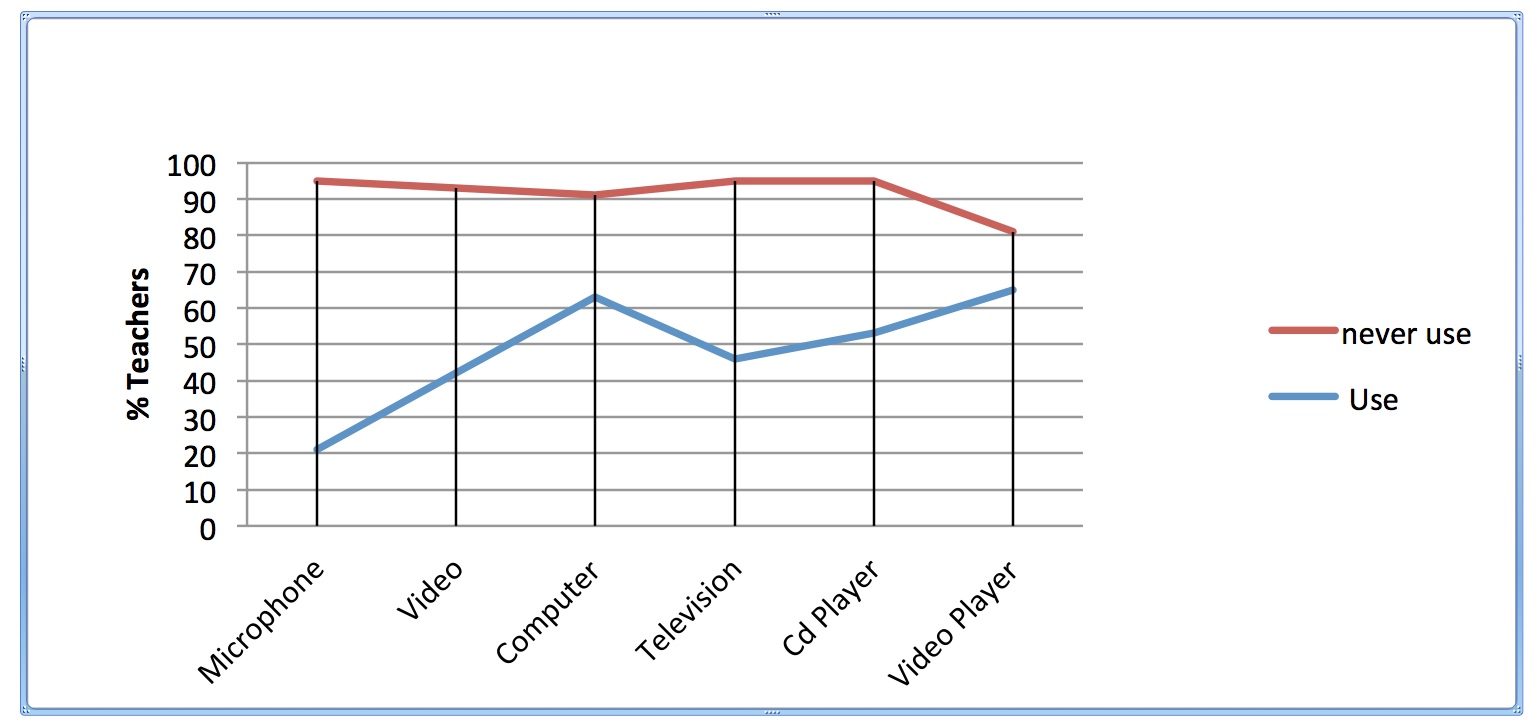
Figure 3: Use of technology in the classroom
Music and song practice are some of the resources the teacher uses the most to plan their lesson (Figure 4 and 5).
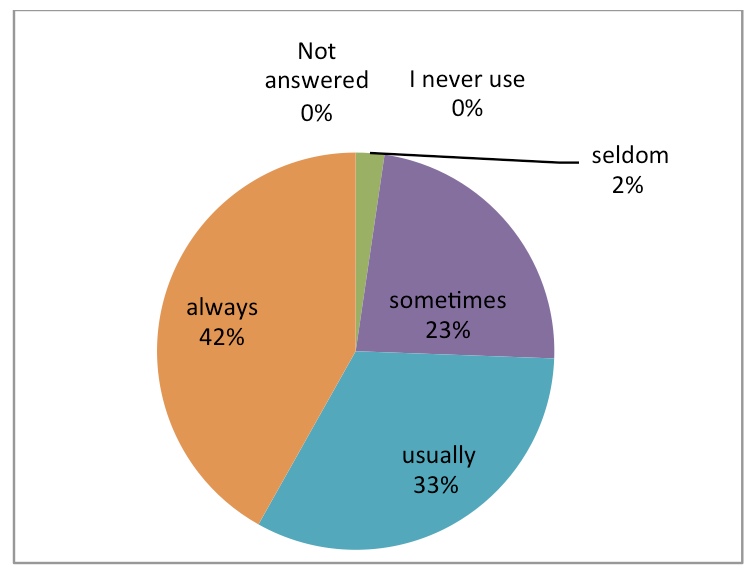
Figure 4: Use of Lyric
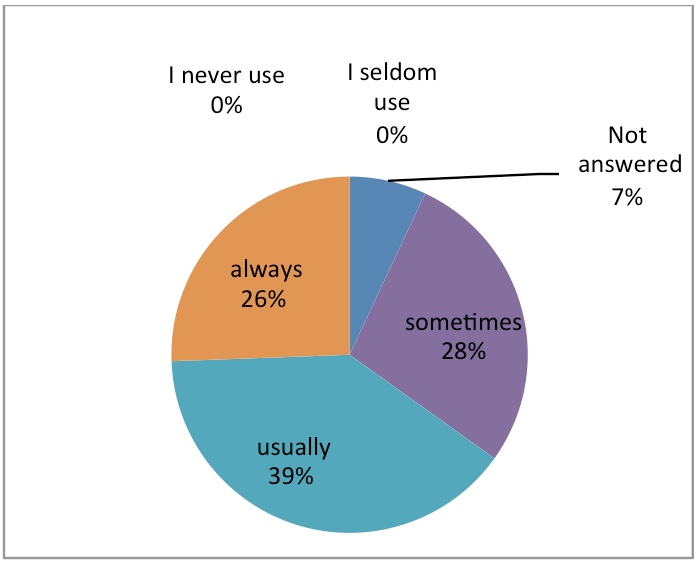
Figure 5: Use of Music
According to the data provided by the teachers of the NEPBE cycle II, we can see in figure 6 that the most popular texts used by teachers in their lesson plan are the short readings texts, however we can also see that most of the texts are not used as often as they should be.
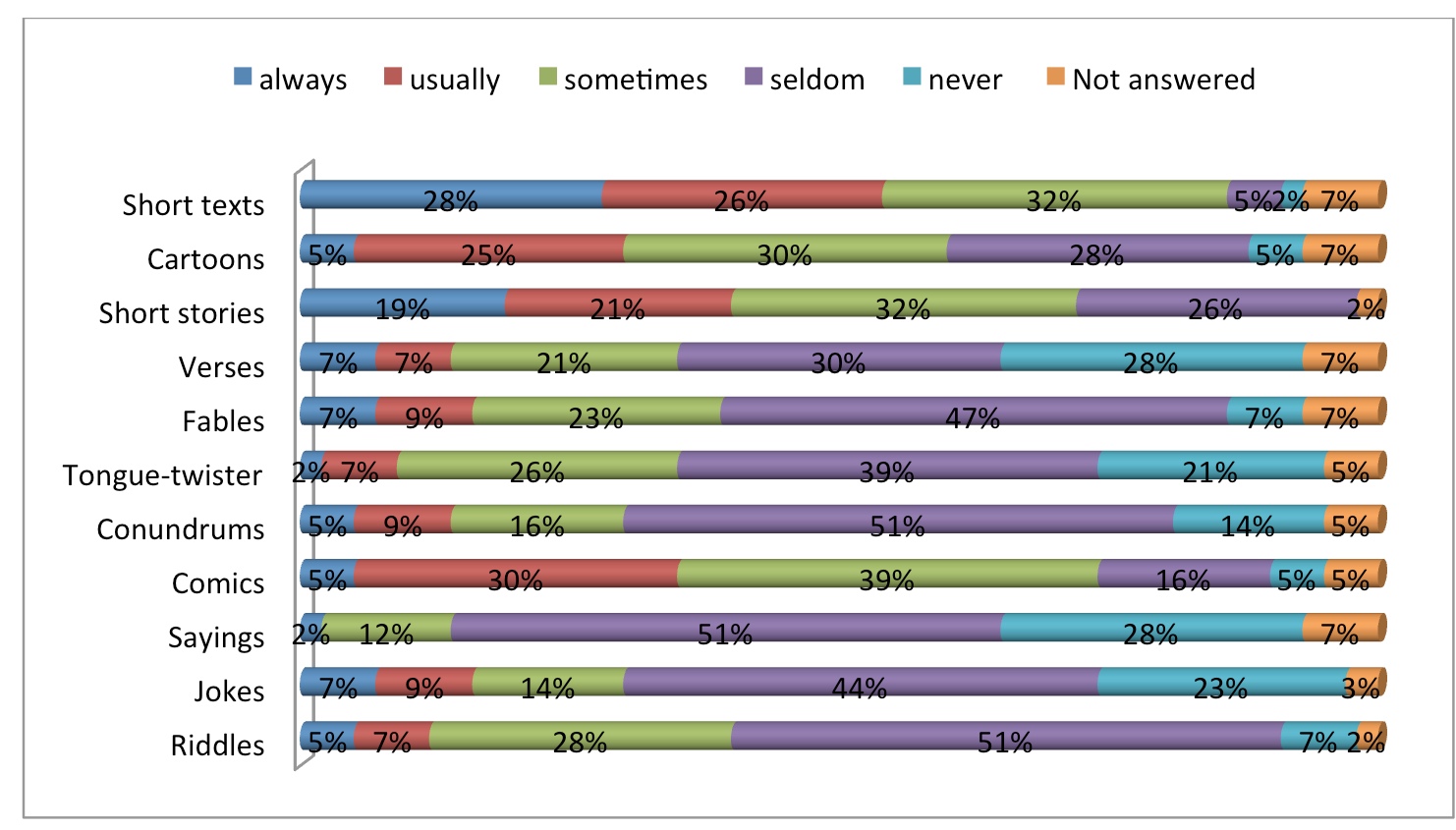
Figure 6: Use of Popular Texts
Information texts are regularly used by the teachers when planning their activities for the lesson. (Figure 7)
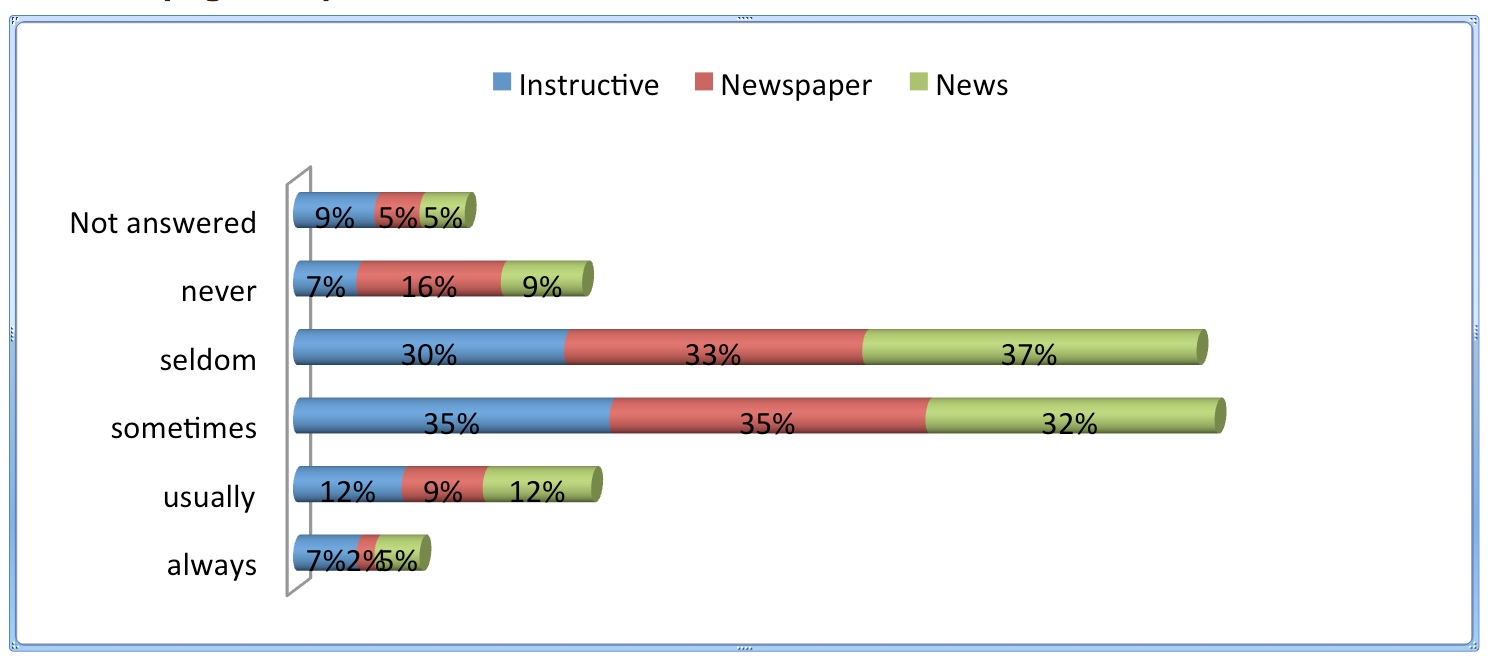
Figure 7: Use of Information Texts
Figure 8 below shows that most of the teachers use recreational resources to plan their lessons for cycle II. Most of the teachers reported that movies, use of the library and use of photographs are not considered in their lesson plan for cycle II or seldom used (Figure 9).
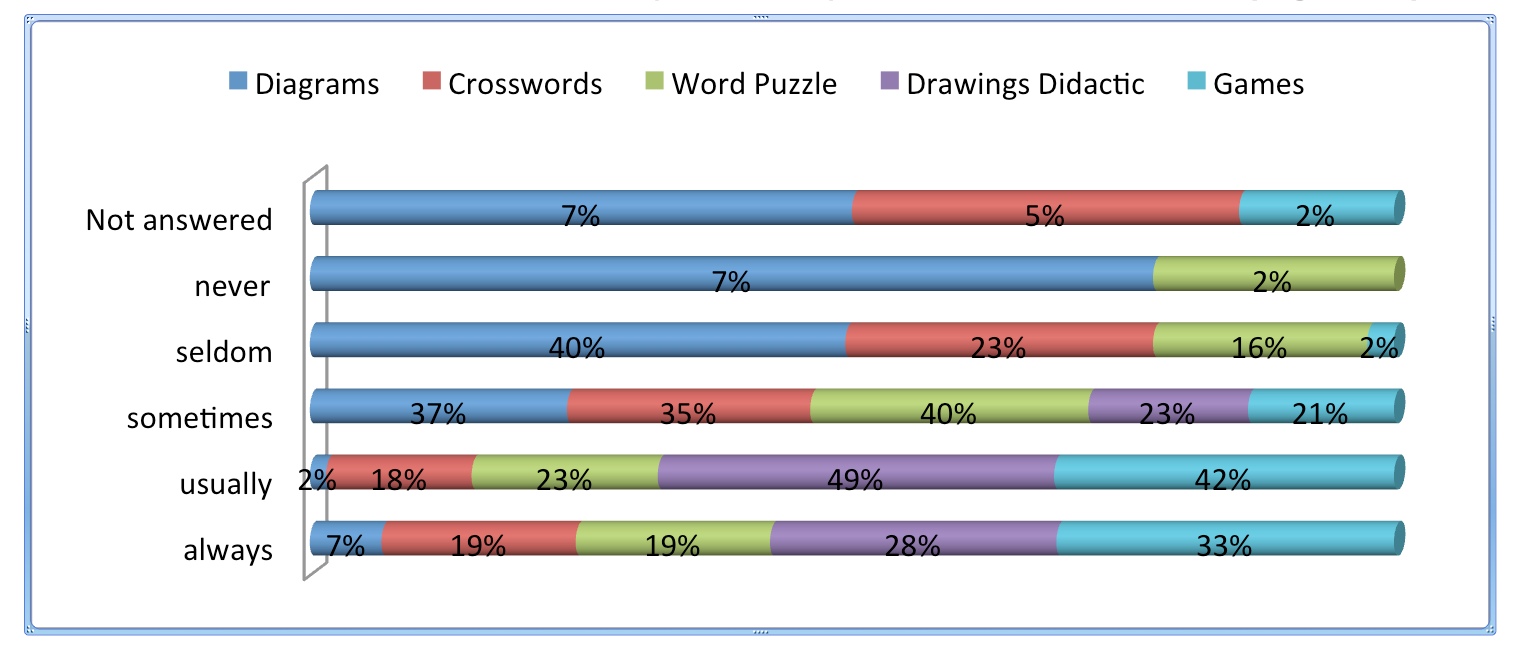
Figure 8: Recreational Materials
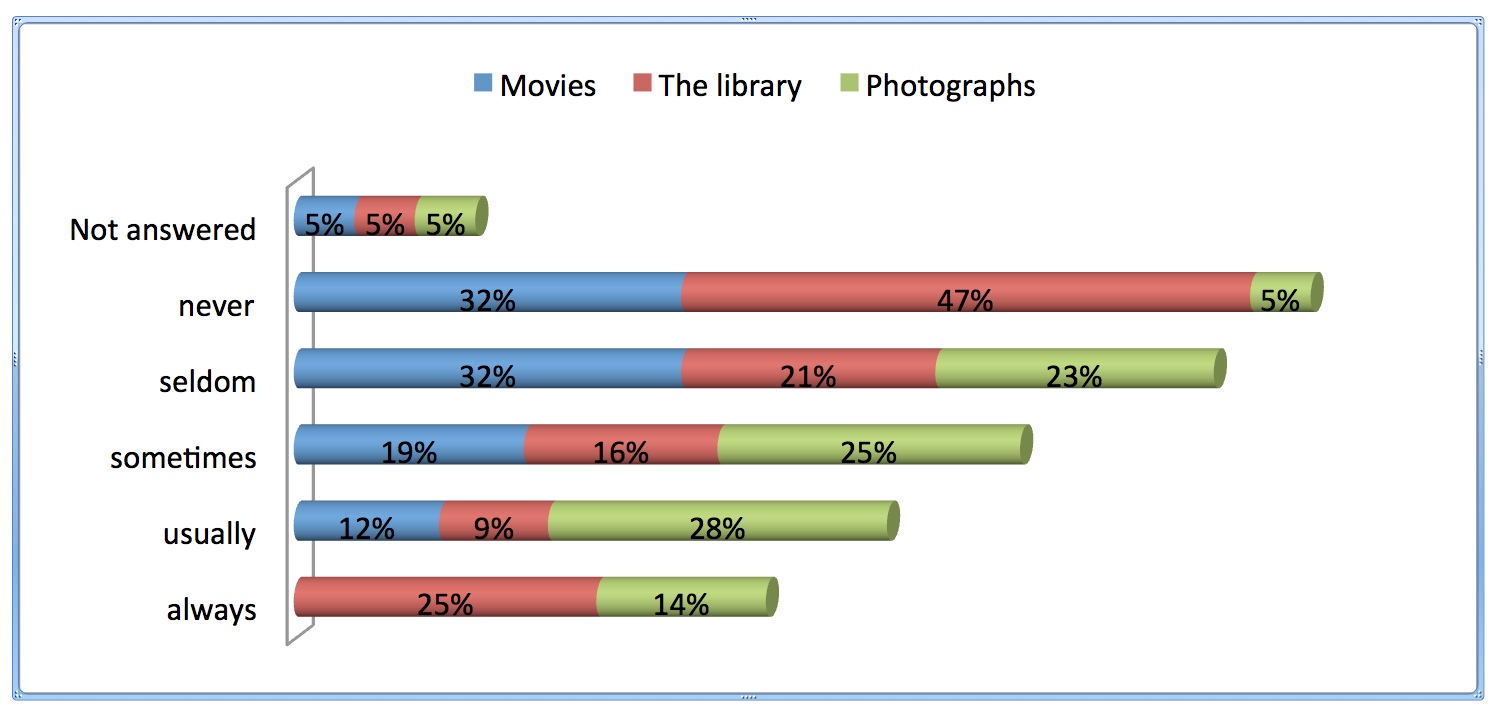
Figure 9: Other Resources
We can see in Figure 10 that in respect to the difficulties teachers face in the NEPBE cycle II of putting into practice the activities suggested by the program, the teacher’s access to technology obtained the highest percentage followed by school facilities, which indicates teachers’ degree of disapproval. We can also observe that teachers expressed that teaching material is good and support of teachers by the authorities is relatively good.
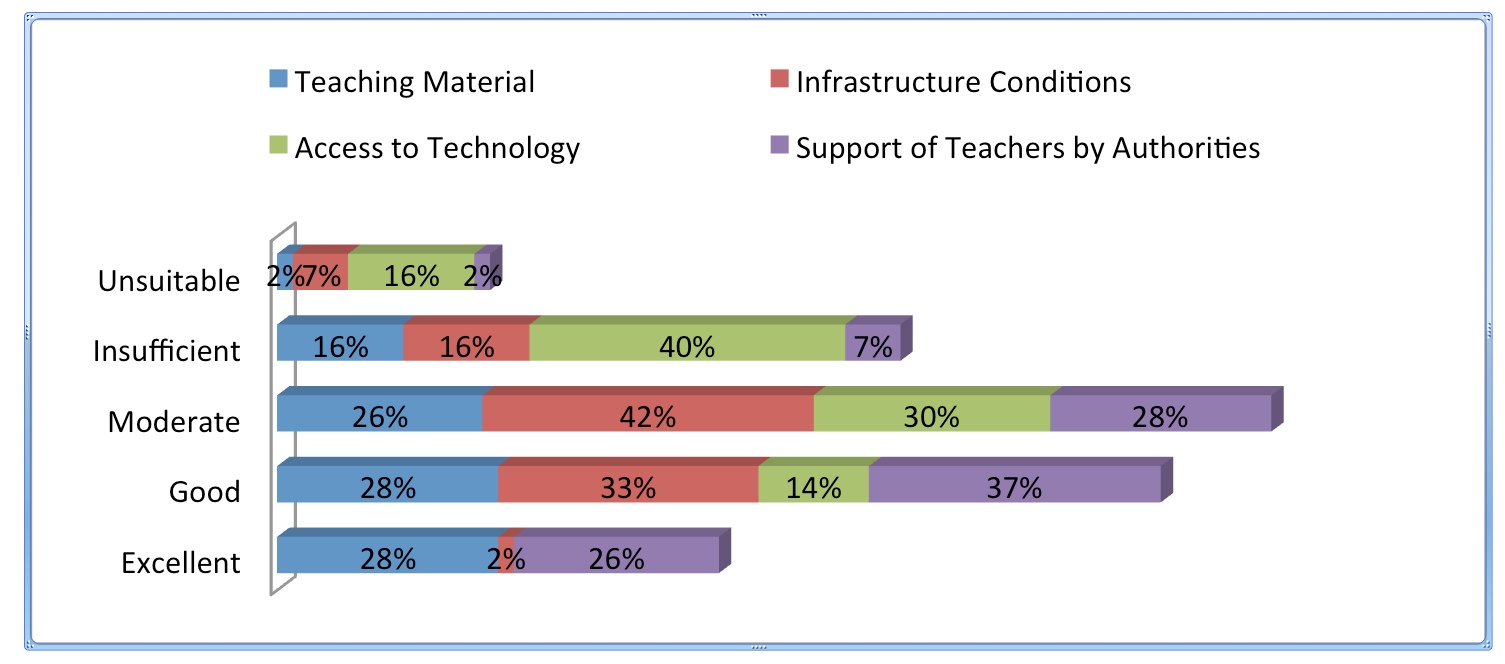
Figure 10: Teacher difficulties
Analysis of findings
In the analysis of the data collected from both instruments, although applied to different teachers and in a different fashion (open and closed questionnaires), several similarities were observed about the teachers’ and students’ perception of the social practices such as: students enjoy physical activities like dancing and singing to music since most at that age are kinesthetic and visual learners and therefore most of the teachers use recreational resources such as crossword puzzles and other games. However teachers do not report using movies or the use of the library, which in turn means students do not read much. Teachers obtain information for planning their lessons from texts, magazines or use of the Internet. However, they do not use technology for applying activities due to the lack of equipment at schools (teachers reported that the school authorities do not provide them with a classroom with everything that is needed for the English class, like: a CD player, stationery, didactic material, data projector, or computer). Teachers state that their main problem when they have to plan their lessons and the activities for the English class is time management, reporting that class time is not enough for the implementation of the activities. They also report problems with designing material for the different stages in order to obtain a product. The teachers expressed their desire to be trained in student discipline and management, as well as the design of teaching-learning strategies, however according to their characteristics (command of English, teaching experience, etc.) and the problems they reported, it is also evident that they need to be trained in material design for teaching English, lesson planning and teaching-learning methods that can be used to implement social practices.
Conclusions
In this study we were able to appreciate that most of the Social practices of language are accepted by both teachers and students, however it has not been an easy task to face the difficulties that interfere with the teachers’ performance, from problems with school facilities to lack of contextualized activities and problems with the articulation of contents.
The information collected in this study shed light on the situation of the NEPBE teachers and students in Nayarit; this information will be useful for helping teachers to implement the social practices according to the type of students they have and the facilities they use. The data collected also provided us with a diagnosis of the teachers involved in the program and their needs for training.
References
Bandura, A. (1987). Pensamiento y acción: Fundamentos sociales. Barcelona. Martínez Roca.
Delors, J., Al Mufti, I., Amagi, I., Carneiro, R., Chung, F., Geremek B., Nanzhao, Z. (1996). La educación encierra un tesoro: Informe a la UNESCO de la comisión internacional sobre la educación para el siglo XXI. Madrid.Santillana Ediciones, UNESCO.
Múnera, E. K. (2007). Estrategias de enseñanza para el aprendizaje del Inglés en el grado primero y segundo de la básica primaria. BuenasTareas.com. Retrieved from: http://www.buenastareas.com/ensayos/Estrategias-De-Ense%C3%B1anza-Para-El-Aprendizaje/2273865.html
Organización para la Cooperación y el Desarrollo Económico. (2001). Scenarios for the future of schooling (chapter3). In What school for the future? Retrieved from: http://www.oecd.org/site/schoolingfortomorrowknowledgebase/futuresthinking/scenarios/38967594.pdf
Piaget, J. (1979). La epistemología genética. Barcelona:A. Redondo
Secretaria de Educación Pública (SEP). (2006). Educación básica. Secundaria. Español. Programas de estudio 2006, México.
Secretaría de Educación Pública (SEP). (2010). Programas de estudio 2010, Ciclo 2, 3° y 4° de primaria. Fase de expansión. Programa Nacional de Inglés en Educación Básica. Segunda Lengua: Inglés. Mexico, D.F. Edamsa Impresiones.
Secretaría de Educación Pública (SEP). (2011). ) Teorías del aprendizaje aplicadas al PNIEB. Coordinación de inglés en el D.F.
Secretaría de Educación Pública, Instituto Tecnológico y de Estudios Superiores de Occidente (SEP, ITESO).(2012). NEPBE – Professional development workshop “Strengthening NEPBE at state level” Cycles 1, 2 and 3. Quijote.biblio.iteso.mx. Retrieved from: http://quijote.biblio.iteso.mx/.
Smyth, J. (1991). Una pedagogía crítica de la práctica en el aula. Revista de Educación 294, 275-300.
United Nations Educational, Scientific and Cultural Organization, Secretaria de Educación Pública y Organización de los Estados Americanos. (2011). Proyecto regional de indicadores educativos, Cumbre de las Américas. Panorama Educativo 2010: Desafíos pendientes. Retrieved from: http://portal.oas.org/LinkClick.aspx?fileticket=0BiOJCtjw58%3D&tabid=1380
Vargas Ortega, R. & Ban, B. (2011). Paso a Paso con el PNIEB en las aulas. México D.F.: Latin America Educational Services.
Villasana Usry, C. V. (2011). La enseñanza del inglés a través de prácticas sociales del lenguaje en un grupo de quinto grado de educación primaria. Retrieved from: http://www.crenamina.edu.mx/Documentos_recepcionales_2007_2011/EXPERIMENTACION_DE_UNA_PROPUESTA_DIDACTICA/CATALINA_VALENTTIA_VILLASANA_USRY.pdf
Vygotsky, L. S. (1995).Pensamiento y lenguaje. Madrid: Paidós

